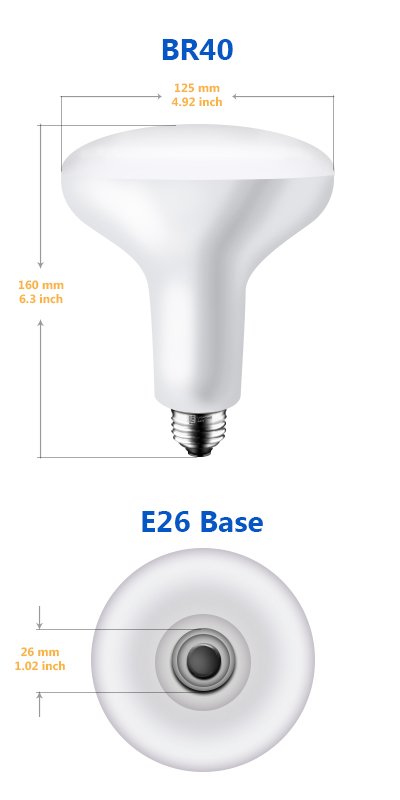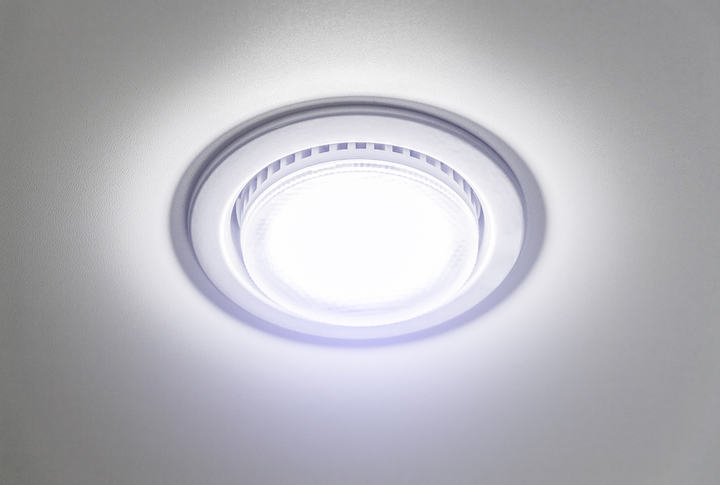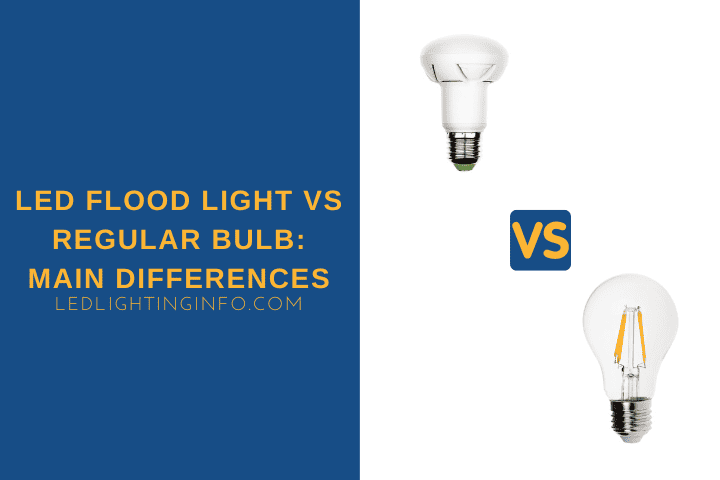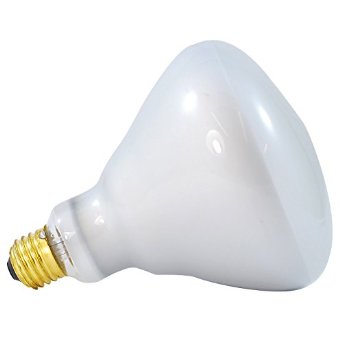Floodlights are some of the brightest bulbs you can buy. They’re designed to emit light over a wider area, ‘flooding’ a room with light.
But what are the main differences between an LED floodlight and a regular light bulb? Would you want to use a floodlight in a regular socket?
The main difference between LED flood lights and regular bulbs is that LED floodlights are designed to illuminate large spaces – often outdoors, or commercial locations. They are bigger, have wider beam angles, and generate more light.
In this article, I’ll take you through:
- The main differences between a floodlight bulb and a standard light bulb
- Whether you can use floodlights in indoor light sockets
6 Differences Between A Floodlight Bulb And A Regular Light Bulb

The main differences between LED floodlights and regular LED bulbs are:
- Size – floodlights are bigger
- Shape – floodlights have a wider beam
- Wattage – floodlights draw more power
- Luminosity – floodlights generate much more light
- Purpose – floodlights are normally used in a commercial or outdoor setting, though not always
- Voltage – floodlights tend to use mains voltage, while many LEDs (but not all) are low voltage.
Here’s a summary table of how a BR40 LED bulb compares to GU10 spotlights and A19 bulbs normally used indoors:
| Difference | BR40 LED Floodlight | GU10 LED Spotlight | A19 LED Bulb |
|---|---|---|---|
| Size | 4.72” diameter | 2” diameter | 2.4” diameter |
| Bulb Shape | Bulged reflector | Flat | Pear-shaped |
| Average Wattage | 12W-18W | 1.8W-11W | 4W-13W |
| Luminosity | Average 1500 Lumens | Average 300 Lumens | Average 600 Lumens |
| Purpose | Brightly illuminate wide spaces | Directional lighting | Ambient lighting |
| Voltage | 120V US, 220-240V Global | 12V | 12V |
Size Of Floodlights Vs. Regular Light Bulbs
While floodlight bulbs will typically have the same E26 base as a regular light bulb, the actual size of the bulb head is much larger. They’re typically BR30 or BR40 lights, which mean they have a width of 3.74″ and 4.72″ respectively across the bulb head.
That means a BR40 is more than double the size of typical spotlight bulb (GU10s measure around 2″ wide) and around twice the size of a common A19 light bulb (which are 2.4″ wide).
Floodlight Bulb Shapes
Most floodlight bulbs are BR lights, though you can also get PAR lights – standing for Parabolic Aluminized Reflector. BR lights tend to have a wider beam, while PAR bulbs are a little more directional, as they only have a slight raise to the bulb head.
Smaller PAR bulbs are what you’d use for most indoor spotlights, with a more narrow beam. And while an A19 bulb will have wide beam angles too, they aren’t as powerful a light and so they produce light in a more gentle, even spread, compared to the intense wide brightness of a floodlight.
Typical Wattage Of Floodlights And Regular Lights
The average wattage of an LED floodlight is between 12 and 18 watts. That does average out as more than a typical smaller indoor bulb, but not by much – certainly nowhere near the wattage drawn by older incandescent light bulbs.
GU10 spotlights use as little as 1.8 watts but can range up to 11 watts – though they are typically 5 watts. A19 bulbs will range from 4 watts to 13 watts normally.
How Much Light Each Produces

The brightness of a light depends on the wattage, but floodlights are typically brighter than other bulbs, because their maximum wattage averages higher. Typical LED flood lamps will average around 1500 lumens.
Regular lighting is lower – expect around 300 lumens for a spotlight (since you tend to use multiple spotlights for a room) while an average for an A19 bulb is closer to 600 lumens, though you can get A19 bulbs with a higher wattage that are a much more powerful light.
The Purpose Of Each Light Type
LED floodlights are designed to be used outdoors or in indoor settings where a lot of light is needed – often in commercial settings. Their purpose is to produce a high amount of light across a wide beam angle to illuminate a large space.
Spotlight bulbs are directional, and tend to be used as task lighting – illuminating the important space directly below. A19 bulbs are more ambient – doing a similar job to a floodlight but for a smaller space, and with a gentler light.
The Voltage Of Each Light Type
LED flood bulbs tend to run on the regular circuit voltage of your home – 120V in the US. That’s unlike many other LED lights, which have a driver lowering the voltage to 12V, since that’s often enough to power an LED.
Certain bulbs share this trait with floodlights – GU5.3 spotlights are another type of spotlight, but they’re too small to have a driver, and so run on mains voltage instead.
Can You Put An LED Floodlight Bulb In A Regular Socket?

You can install an LED floodlight bulb in any socket and fixture in which it fits. If the base type matches the fitting, and it has enough space in a fixture then the bulb will work. Many LED floodlights use the same E26 base as a regular A19 light bulb.
Floodlights tend to be used for larger spaces, both indoor and outdoor. They might be used as a security light for your garden or to illuminate a warehouse.
However, you might choose one for an office space, your garage (mainly if you spend your evenings and weekends working on your car), or even for an open plan room in your home.
They’re very wide-angled and very bright, so you need to check that you’re happy with that before you commit. Even if you use them outdoors, they can be too bright for some tastes.
As there are so many different uses of a floodlight bulb, you’ll be relieved to know that you don’t need to replace all of your light fittings if you decide to install one.
FAQ
Can You Use Floodlights Inside?
You can use LED floodlight bulbs inside your home, provided the base fits the indoor fixture, and the bulb isn’t so big that it fills any recess, restricting airflow around the bulb. Larger floodlight bulbs will need a heat sink installed in the fixture to remove excess heat.
Can I Replace Halogen Flood Lights With LED?
You can replace halogen flood lights with LEDs. You’ll also need to check that the halogen light wasn’t using a transformer to lower the voltage. It likely wasn’t for a floodlight, but if it was you’d need to disconnect the transformer for the LED bulb to work.
Are All Floodlights The Same Size?
Flood lights are not all the same size, so it’s important to check when buying so that you get one that fits the space. Buying too big a bulb can mean an excess amount of heat generated if there isn’t space around the bulb, which can reduce its lifespan.
Final Word
When it comes to LED light bulbs of any kind, the general rule of thumb is that if it fits, then it will work.
The only difference is when replacing halogen bulbs with LED bulbs, because then you need to make sure you’re not connecting a newer bulb in a socket with a transformer.
And with floodlights, you need to be sure you actually want that bright of a bulb in the fixture you’re installing it in!
If you still need help, I have a guide all about whether you can install LED lights in any fixture – why not check that out next?
Looking for an LED bulb but not sure what type you need?
Check out my free bulb picker and select the right bulb within few clicks.


